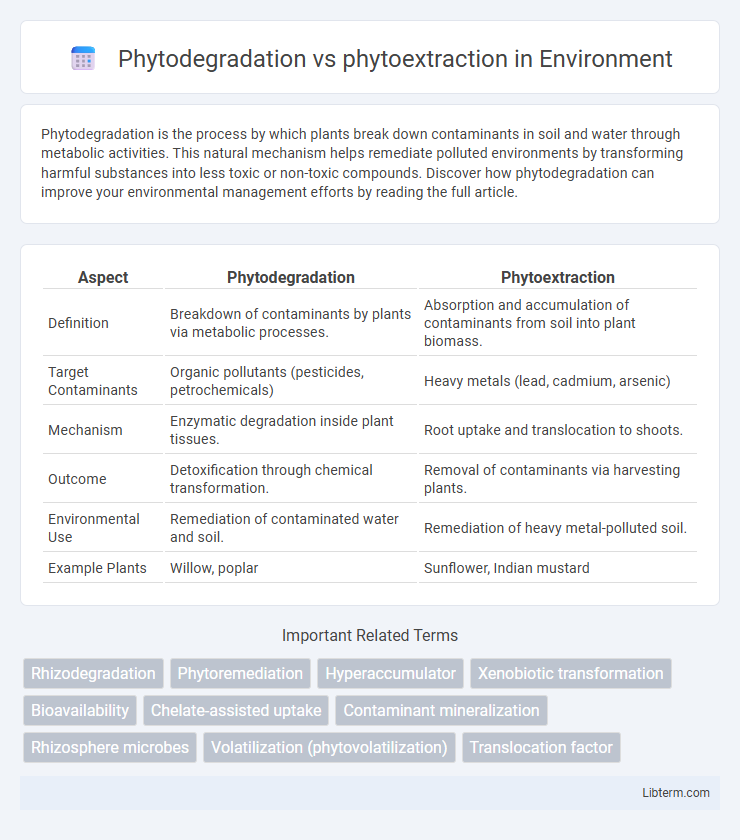Phytodegradation is the process by which plants break down contaminants in soil and water through metabolic activities. This natural mechanism helps remediate polluted environments by transforming harmful substances into less toxic or non-toxic compounds. Discover how phytodegradation can improve your environmental management efforts by reading the full article.
Table of Comparison
| Aspect | Phytodegradation | Phytoextraction |
|---|---|---|
| Definition | Breakdown of contaminants by plants via metabolic processes. | Absorption and accumulation of contaminants from soil into plant biomass. |
| Target Contaminants | Organic pollutants (pesticides, petrochemicals) | Heavy metals (lead, cadmium, arsenic) |
| Mechanism | Enzymatic degradation inside plant tissues. | Root uptake and translocation to shoots. |
| Outcome | Detoxification through chemical transformation. | Removal of contaminants via harvesting plants. |
| Environmental Use | Remediation of contaminated water and soil. | Remediation of heavy metal-polluted soil. |
| Example Plants | Willow, poplar | Sunflower, Indian mustard |
Introduction to Phytoremediation Strategies
Phytodegradation and phytoextraction are key phytoremediation strategies used to remediate contaminated soils and water. Phytodegradation involves the breakdown of pollutants through enzymatic processes within plants, effectively transforming organic contaminants into less harmful substances. Phytoextraction focuses on the uptake and accumulation of heavy metals or toxins in plant tissues, enabling their removal from the environment through harvest and disposal.
What is Phytodegradation?
Phytodegradation is a process where plants break down pollutants and contaminants into less harmful substances through metabolic activities, often involving enzymes that degrade organic compounds in soil or water. Unlike phytoextraction, which involves the uptake and accumulation of contaminants in plant tissues for removal, phytodegradation transforms pollutants directly within the plant system, reducing environmental toxicity. This method is particularly effective for organic contaminants such as pesticides, herbicides, and industrial solvents.
What is Phytoextraction?
Phytoextraction is a bioremediation process where plants absorb and concentrate heavy metals or contaminants from soil into their harvestable tissues. This method effectively removes pollutants by extracting toxic elements such as lead, cadmium, or arsenic through the roots and storing them in shoots or leaves. Phytoextraction is often utilized for cleaning up contaminated sites by harvesting and disposing of the contaminated biomass safely.
Key Mechanisms: Phytodegradation vs Phytoextraction
Phytodegradation involves the breakdown of contaminants within plant tissues through enzymatic activity, transforming toxic substances into less harmful compounds. Phytoextraction, in contrast, relies on the uptake and accumulation of heavy metals or pollutants from soil into the harvestable biomass of plants for subsequent removal. Both mechanisms play crucial roles in phytoremediation strategies targeting soil and water contamination.
Types of Contaminants Targeted
Phytodegradation targets organic contaminants such as pesticides, solvents, and petroleum hydrocarbons by breaking them down into less harmful substances through plant metabolic processes. Phytoextraction focuses on inorganic contaminants like heavy metals, including lead, arsenic, and cadmium, by accumulating these metals in plant biomass for subsequent harvesting. Both mechanisms serve distinct remediation purposes based on the chemical nature of the environmental pollutants present in soil or water.
Advantages of Phytodegradation
Phytodegradation offers the advantage of breaking down complex organic pollutants into less harmful or non-toxic substances through enzymatic processes within plant tissues, effectively reducing soil contamination. This method enhances ecological restoration by minimizing secondary waste generation common in other remediation techniques. Its ability to target a broad spectrum of organic contaminants, including pesticides and industrial solvents, makes phytodegradation a sustainable and cost-effective solution for environmental cleanup.
Benefits of Phytoextraction
Phytoextraction leverages hyperaccumulator plants to remove heavy metals and toxins from contaminated soils effectively, restoring land usability for agriculture and habitation. This method is cost-efficient, eco-friendly, and minimizes soil disruption compared to mechanical remediation techniques. Enhanced metal recovery through phytoextraction supports resource recycling and reduces environmental pollution.
Challenges and Limitations
Phytodegradation faces challenges such as the limited enzymatic capacity of plants to break down complex pollutants and the potential accumulation of toxic metabolites in plant tissues, restricting its effectiveness for certain contaminants. Phytoextraction is limited by slow metal uptake rates, the potential toxicity of heavy metals to plants, and the need for multiple harvesting cycles to achieve significant soil remediation. Both methods are constrained by plant species specificity, environmental conditions, and the bioavailability of contaminants in the soil matrix.
Comparative Case Studies
Comparative case studies reveal phytodegradation excels in breaking down organic pollutants such as pesticides and industrial solvents through plant metabolic processes, notably in species like poplars and willows. In contrast, phytoextraction is more effective for removing heavy metals like lead and cadmium from contaminated soils using hyperaccumulator plants such as Brassica juncea and Thlaspi caerulescens. Field trials demonstrate phytodegradation achieves faster detoxification in organic contaminant hotspots, while phytoextraction significantly reduces metal concentrations but typically requires longer remediation periods and biomass disposal management.
Future Perspectives and Applications
Phytodegradation and phytoextraction hold promising future perspectives for sustainable environmental remediation with increasing applications in soil and water detoxification. Advances in genetic engineering are expected to enhance the efficiency of phytodegradation by enabling plants to metabolize complex pollutants, while phytoextraction's potential is expanding through the development of hyperaccumulator species that can recover valuable metals and remediate heavy metal contamination. Integration of these technologies with precision agriculture and biotechnological tools is anticipated to optimize phytoremediation strategies, making them viable for large-scale deployment in industrial and urban settings.
Phytodegradation Infographic

 libterm.com
libterm.com